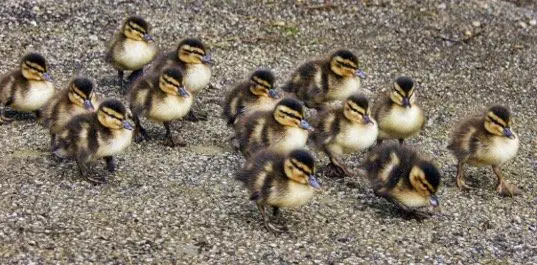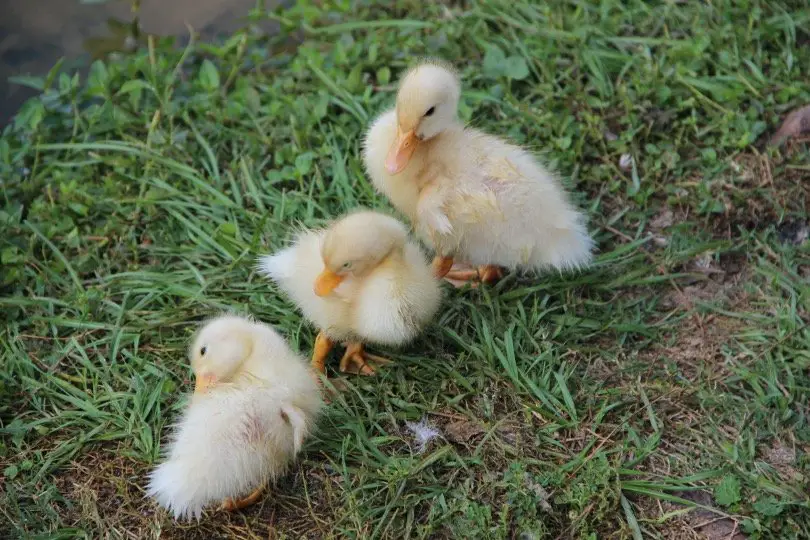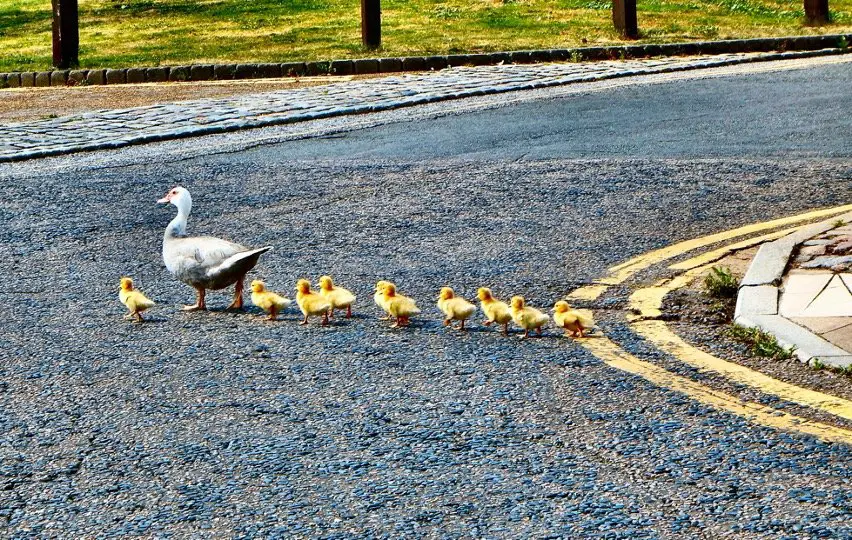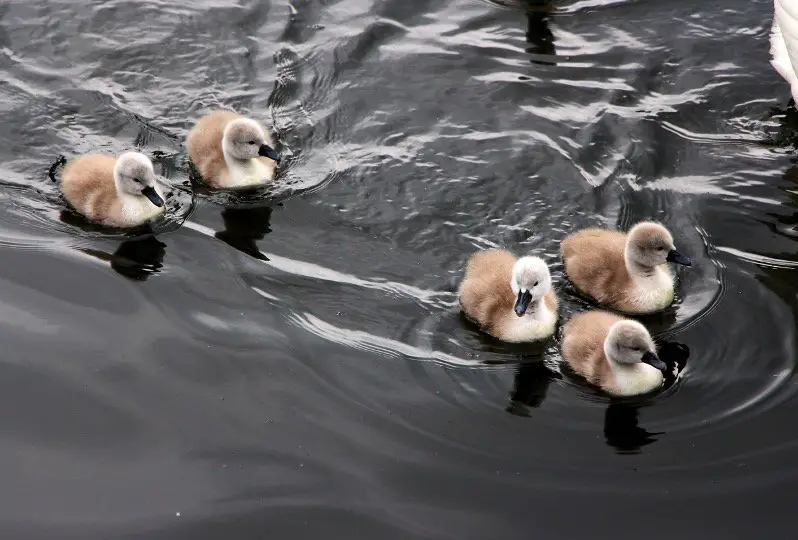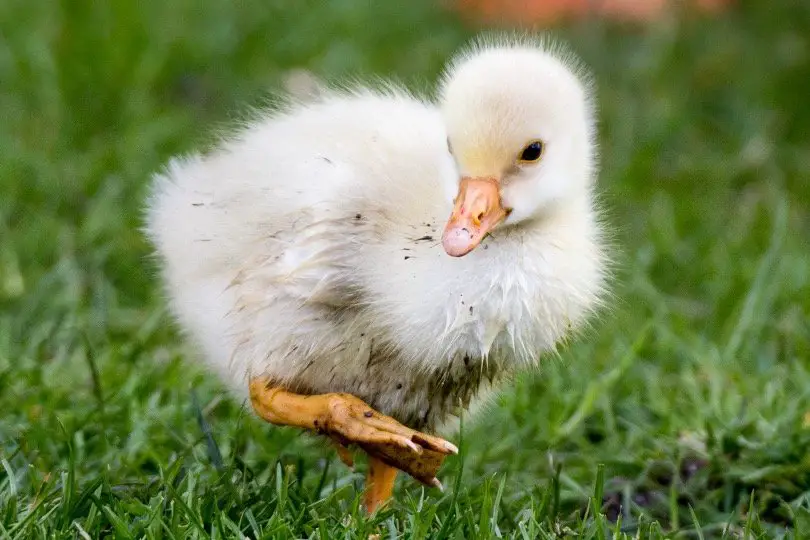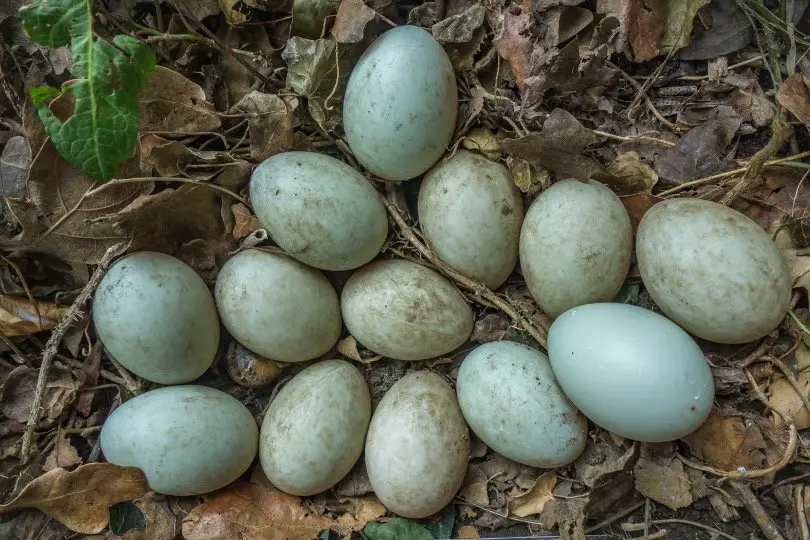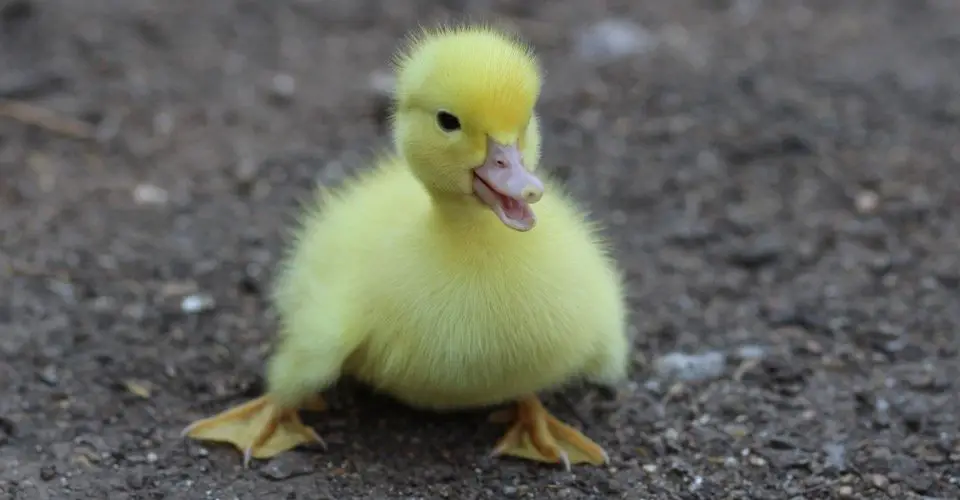Baby Duck: All The Facts, Care, and Pictures
Ducks are a huge group of waterfowl in the Anatidae family, which also includes swans as well as geese. Ducks are the tiniest, shortest, and most compact members of the family.
They comprise everything from the stunningly decorative Mandarin duck to the simple Mallard as well as a plethora of other stunning species. But what about the little ducklings?
Ducklings are among the most well-known of all newborn birds, spending most of their early lives either floating on the water or waddling with their moms on dry land. This article will teach you everything you need to know about newborn ducks.
What Does A Baby Duck Look Like?
Most ducklings resemble what most people think of as a normal duckling: tiny as well as fluffy with huge webbed feet. There are differences between duck species and their ducklings.
Mallard ducklings have yellow bellies as well as necks with darker down over their heads, wings, and backs, making them the archetypal duckling. These darker spots frequently create longitudinal stripes along their bodies.
Pekin ducklings lack the black down and instead have a brilliant blonde color. Many eider ducks have darker ducklings, whereas Goldeneye ducklings are likewise dark grey.
Wigeon ducklings are leaner as well as taller than other kinds of ducklings. All ducklings have one thing in common: they hatch coated in a thick as well as fluffy down.
What Does a Baby Duck Called?
Ducklings are young ducks. The word duck is a popular name with no clear official scientific meaning, as well as many species classified as ducks are not truly related to one another. Nonetheless, all baby ducks are referred to as ducklings.
“A baby duck is called a Duckling!”
A duckling or chick is a baby duck of any gender. A brood is a bunch of ducklings on land. Ducklings cannot fly, but once they do, a group of ducks in the air is referred to as a skein, team, or flock of ducks.
Baby Birds: All the Facts, Care, and Pictures
On the water, the group is known as a paddling, raft, or duckling team. A duckling is a duck until it reaches the age of four to six months as well as is ready to mate. This is the point at which the nomenclature shifts. A completely mature male duck is referred to as a drake, while a fully developed female duck is referred to as a hen.
What Do Juvenile Ducks Look Like?
At roughly 1 to 3 months, juvenile ducks begin to grow adult plumage, at which point males become increasingly difficult to identify from females. Ducks are sexually dimorphic in general, with males having flashier, brighter, as well as more colorful feathers.
This is visible in species like the Mallard as well as Mandarin duck, but much less so in runner as well as Pekin ducks. If we take the male Mandarin duck, which is one of the most beautiful as well as colorful ducks, its youngsters are still quite plain until they reach full maturity.
After just 3 to 4 months, male Mallard youngsters begin to display their distinctive blue speculum feathers. Many female ducks appear the same as youngsters as they do as adults.
How Big Are Baby Ducks?
Most kinds of baby ducks are tiny, typically less than 10cm in length. A typical brood of ducklings can have a good degree of size variability, so some will be bigger than their siblings.
Ducklings develop swiftly and attain skeletal maturity in around 2 to 3 months, however it will take another year and a half before they are ready to reproduce. It might take up to a year for male plumage to fully mature.
How Much Do Baby Ducks Weigh?
Mallard ducklings weigh between 30 to 40 grams (1.0 to 1.4 oz). Fully grown ducks range in weight from 0.45kg for the tiniest species, such as Call ducks, to 6.8kg for the huge Muscovy duck. As a result, there will most likely be some variance in the sizes of ducklings, although they will most likely weigh in the same range.
Do Newborn Ducklings Don’t Have Feathers?
One of the most noticeable characteristics of ducks is their gorgeous feathers. You might be astonished to find that newborn ducks do not have feathers when they are born. Instead, they are encased in a soft, fluffy coating known as down.
Ducklings have just their down feathers during the first three to five weeks of their existence. Due to the importance of duck feathers in body temperature control, newborn ducks can only spend warm, sunny days outside.
Ducklings go through a juvenile plumage molt when they are around six weeks old. During this stage, chicks will lose all of their down feathers to allow their adult feathers to emerge. The entire process takes around six weeks, as well as the resultant feathers are dull-colored as well as will shed again around the age of 15 weeks.
Do Ducklings Have Waterproof Feathers?
When a newborn duck’s feathers grow, it will preen them with an oily material on a regular basis. The duck’s preen gland produces this unique oil. Ducklings take this oil and distribute it throughout their feathers with their beak, making them entirely waterproof.
If you’re wondering why an animal that spends so much time in water need impermeable feathers, look no further. There are several causes for this!
For starters, their waterproof outer covering protects a layer of downy feathers beneath, which is vital for keeping ducklings warm. Waterproof feathers also prevent newborn ducks from absorbing too much water on their bodies, which might prevent them from floating or even flying!
How Do Ducks Feed Their Chicks?
Ducklings can feed themselves within days after hatching; the parents (in the great majority of cases, just the mother) simply direct them to edible items. She will nibble at edible things while conversing with her ducklings through vocalizations.
They’ll also eat part of their hatching egg yolks, which will give them with food for the first several days.
What Do Baby Ducks Eat?
The food of a normal duckling differs depending on the species. Mallards, pintails, as well as other ducks eat mostly water vegetation. Mergansers as well as Pekins, for example, feed largely fish as well as other aquatic creatures, as well as insects, amphibians, as well as crabs.
Baby Birding Food: A Complete Guide
Ducks are technically omnivores, meaning they will eat a range of things depending on their aquatic habitat. Many ducks forage for food on the ground as well.
Ducklings, unlike many other newborn birds, can feed themselves just days after hatching as well as will monitor their mother for indications that indicate what they can as well as cannot eat.
Baby ducks eat pondweed as well as duckweed, among other things. Plants in the water Worms of Algae Crustaceans of varying sizes Insects as well as the larvae of insects Mollusks of varying sizes.
What to Feed Baby Ducks?
Take out your baby duck starting kit the day they hatch from their egg. This package includes duck meal pellets that are soft enough for their sensitive beaks to nibble on.
You may also get supplements like calcium pills as well as a duck toy to play with in your pond or water area. You should be able to start feeding your duckling tiny insects as well as worms after a few weeks.
If feasible, you may let them roam around in a secure area of your yard, or you can provide food for them to locate. Keep an eye on young ducks while they are feeding to prevent them from choking. Also, remove any remaining food after a few hours to prevent it from rotting.
How Often to Baby Duck Feed?
Ducklings mature swiftly, attaining full maturity in a few of months. Some duckling breeds develop quicker than others, but there is no such thing as too much food for newborn ducks!
This is mostly due to their rapid digesting rate, which means they consume quickly as well as then seek more. To ensure that your ducklings develop as much as possible, give them worms or insects every day as well as fish at least twice a week.
While some people advocate feeding your ducklings on demand or every four hours, you may alternatively let them free-feed. Food is always accessible to your ducklings when they are free-fed, as well as they eat when their bodies tell them to.
What Do Baby Ducks Eat in the Wild?
Ducklings emerge from their eggs in the wild as well as remain close to their mother. She takes them to a good spot for the ducklings, where they will be able to find food as well as water.
A natural newborn duckling will consume practically everything, including worms, insects, algae, as well as plants. When the weather is nice, they may feed during the day. However, as winter comes in colder areas, they will need to be near water since their food may freeze.
They also consume a lot of grass as well as weeds in the summer, which might make it difficult for them to digest in the winter since it fills them up. This is risky because their stomachs may not stretch when they start eating different things. Their diet evolves to include more insects as well as even tiny fish as they develop.
Should You Feed Wild Ducks?
The subject of whether or not to feed wild ducks is fraught with ambiguity. Many people believe that feeding wild animals would make them reliant on humans for sustenance, as well as that the animals will eventually become violent and deadly.
Others argue that feeding wild ducks is harmless as long as you don’t attract predators like hawks as well as foxes by leaving crumbs on the ground.
Baby Owl: All The Facts, Care, and Pictures
Feeding ducks in authorized settings, such as nature reserves, where the animals are secure from predators as well as have plenty of water to drink is regarded pretty safe. Feeding wild ducks directly on a pond or lake, on the other hand, might attract pests such as seagulls as well as geese.
Other birds as well as animals may struggle to locate food throughout the winter, placing them at risk of famine. If you wish to feed wild ducks, it is advisable to buy organic food as well as carry fresh water in a bucket rather than leaving crumbs from your kitchen.
What Do Duck Eggs Look Like?
Duck eggs vary greatly in color, even among individuals of the same species or breed. Eggs from mallard ducks can be white, brownish, or even somewhat blue. Blue-tinted eggs are frequently laid by Indian Runner as well as Magpie ducks. The eggs of other ducks range in color from brown to whitish.
When Do Ducks Lay Eggs?
Few duck species lay eggs all year, with most preferring to lay their clutch during the traditional breeding season, which runs from mid-March to the end of July in much of the Northern Hemisphere.
Some ducks, such as the Black-Bellied whistling duck, reproduce in Central America as late as November. Ducks that breed in warmer places are more likely to vary from the usual breeding season (spring) than those that breed in colder or more temperate regions.
There are a few duck species that may have two broods in a year, including the Wood duck, which has been observed to have two broods instead of the customary one, but infrequently.
When Can Baby Ducks Fly?
Ducklings spend much of their early days swimming as well as waddling around, as well as they won’t try their first flight for at least 40 days, if not 60. They will initially attempt to fly short across the water before attempting to land, where a botched landing may not be so pleasant!
When Do Baby Ducks Leave Their Nests?
Baby ducks rely on their mother for warmth for about a week as well as then stay under her constant supervision for another two months or so until they are ready to fly.
Baby Penguins: All The Facts, Care, and Pictures
Ducklings will not become independent right away after hatching, but will most likely join a neighboring flock, frequently with numerous other juvenile ducks. Most duck species reach sexual maturity around one as well as a half to two years, at which point they begin to look for a mate.
Do Ducks Reuse Their Nests?
Ducks often make small, hidden nests close to water, usually within 100 meters or so. The nest may be abandoned immediately after the ducklings hatch, but that doesn’t imply the ducks won’t return to the same nesting place the following year.
According to one research, around 75% of female Canvasback ducks returned to the same nesting spot, with many returning to the same pothole where they nested the previous year.
How Long Do Baby Ducks Stay With Their Parents?
The majority of ducks are seasonally monogamous, which means they develop a new pair bond each mating season, however others, such as whistling ducks, are monogamous.
Some duck pairings have been observed re-mating with one another each season. In any event, most male ducks spend little time with their young after they hatch, however some have been seen remaining protective of their brood until the conclusion of the mating season.
There are several exceptions to the rule: wood ducks as well as whistling ducks are often monogamous as well as even share brooding chores, which distinguishes them from most other duck species. Both the Wood duck as well as the Australian wood duck have been observed caring for their ducklings in a biparental manner.
Baby Pigeons: All The Facts, Care, And Pictures
Among practically all other duck species, the mother is in charge of the majority of the rearing chores. She will keep a careful check on her brood for around two months, at which point the ducklings begin to fledge.
What Is The Survival Rate Of Ducklings?
Ducklings have a high mortality rate; if the winter preceding the mating season is extremely severe, up to 70% of them may perish.
Ducklings confront a variety of challenges, including predation by animals such as foxes, racoons, as well as minks, fish such as bass as well as pike, reptiles such as snapping turtles, as well as a variety of birds like as hawks as well as owls.
This is one of the reasons why duck broods are so large, frequently including 10 ducklings or more, as survival rates are poor.
Do Baby Ducks Never Get Their Feet Cold?
You’re certainly aware that newborn ducks have webbed feet, but did you realize that their feet never get cold? Ducklings are born with a particular circulatory system that protects them from frostbite in cold temperatures.
This system is placed at the top of their legs as well as sends heat down to their feet. Ducklings’ webbed feet are likewise devoid of blood vessels as well as nerve endings. This implies they can’t feel the water no matter how cold it is.
That means they can swim in freezing water as well as even walk over snow without feeling too chilly! It’s easy to imagine that a duckling’s webbed feet aid in swimming. The skin between their toes allows them to utilize their feet as paddles, propelling them faster through the water.
Surprisingly, these small ducks will also utilize their feet as a flying gear. Ducks use their feet as rudders in the air to help them steer.
How Baby Ducks Keep Themselves Safe?
Snakes, bears, as well as even wolves are among the numerous terrifying predators of a newborn duck. They can fly, but they aren’t particularly quick swimmers. A duck’s average swimming speed is about 8 miles per hour, which is roughly the pace of a typical human runner.
This implies they’ll have to get innovative in order to protect themselves from dangers. Traveling in groups is one of the most prevalent ways ducklings defend themselves. Ducks can identify hazards more easily as well as swiftly when traveling in groups of peers.
Baby Eagle: All The Facts, Care, and Pictures
Ducks are also incredibly sociable creatures that require connection in order to flourish. Ducks typically grow lazy as well as melancholy when they are alone. Ducklings do not just defend themselves by traveling in groups.
They are also capable of sleeping with one eye open – literally! Ducks can only turn off half of their brains when it’s time to sleep. As a result, the other half is awake as well as vigilant, ready to identify predators.
Baby ducks will only totally shut down if they are in a safe environment, such as the midst of a flock of ducks paddling.
What If I Found a Baby Duck?
Ducklings as well as goslings are considered “precocial” newborns. That implies they can move, swim, as well as eat on their own very immediately after hatching. They still rely on their parents to keep them safe from predators, to teach them about the world, as well as to keep them warm.
Waterbird chicks are coated in fluffy feathers known as “down.” The feathers might be yellow, brown, greenish, black, or white. They all have webbed feet to aid in swimming.
Put the baby bird(s) in a cardboard box large enough for them to move about in as well as cover with a soft towel or t-shirt to keep them safe until you find out how to help them. Even on a nice day, newborns might become cold, so provide them with a heat source:
• one minute in the microwave with a clean sock stuffed with dry, uncooked rice
• a recycled plastic bottle filled with hot tap water as well as wrapped in a face cloth or tea towel
• a “LOW” setting electric heating pad put beneath half of the box Give them no food or drink – keeping them warm in a dark as well as quiet environment is more vital for now. Contact a wildlife rehabilitator as soon as possible.
FAQs (Frequently Asked Questions)
What Are Baby Ducks Called?
Ducklings are young ducks. When ducklings are on land, they are referred to as a brood. After four to six months, a female duck is referred to as a hen, while a male duck is referred to as a drake. When ducklings reach sexual maturity, they are termed adults.
How Much Do Baby Ducks Weigh?
At birth, most ducklings weigh only a few grams. The Wood Duck, for example, weighs between 12 as well as 17 grams at birth, but the Black Cayuga weighs between 38 as well as 50 grams.
What Do Baby Ducks Eat?
Ducklings are omnivores, meaning they will eat practically everything. Their food consists of a diverse range of invertebrates, weeds, grass, as well as even algae! As the young duck grows older, it will eat tiny fish as well as water invertebrates.
Where Do Baby Ducks Live?
With the exception of Antarctica, baby ducks dwell everywhere humans do.
